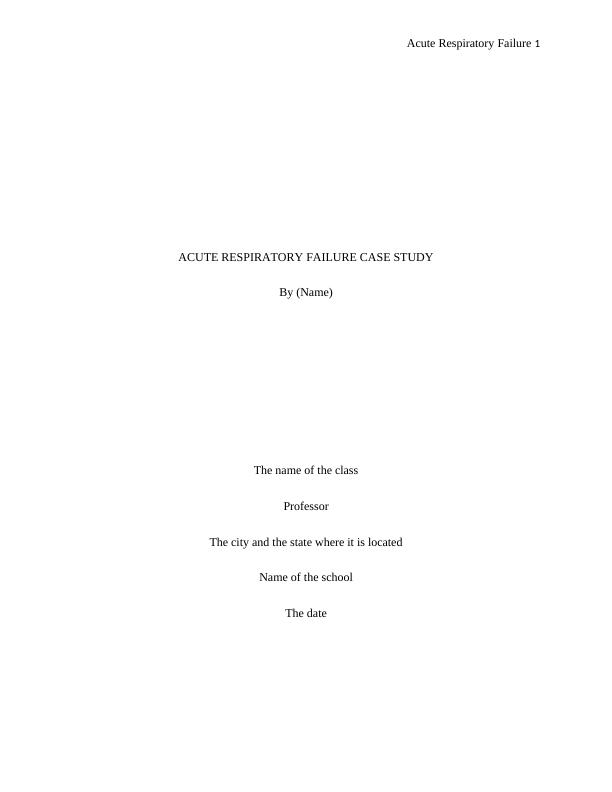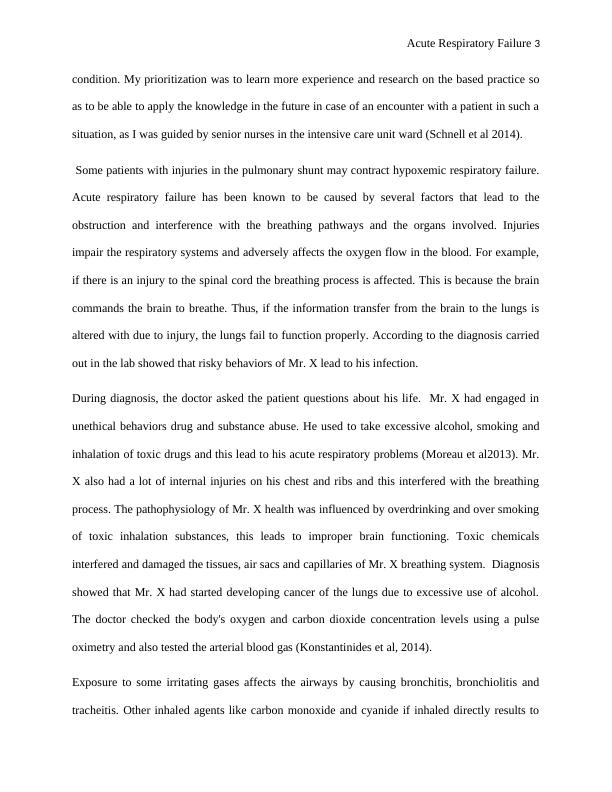Acute Respiratory Failure: Causes, Symptoms, and Diagnosis
Added on 2021-04-24
11 Pages3227 Words163 Views
Acute Respiratory Failure 1ACUTE RESPIRATORY FAILURE CASE STUDYBy (Name)The name of the classProfessorThe city and the state where it is locatedName of the schoolThe date

Acute Respiratory Failure 2The concept of this essay relates to the history of "Mr. X" who had suffered the acute respiratoryfailure. The essay begins with the discussion of Mr. X condition with relevant to his history ofsigns and symptoms and the result's assessment. It will also incorporate the generalpathophysiology process of acute respiratory disease in relation to Mr. X's health conditions. Theessay will define the respiratory disease and also the major causes of the infection will alsodiscuss on the relationship between clinical condition assessment findings and Mr. X symptomswith pathophysiology occurring, Patients symptoms and typical assessment findings beinganalyzed. The conclusion will be based on the significance themes being discussed. A 65-year-old man who will be known as Mr. X to protect his identity is admitted to the hospitaldue to acute respiratory failure. Some of the symptoms that Mr. X had when he was admitted tothe hospital include; tachypnea, peripheral vasodilation, cyanosis, tachycardia and bilateral finerespiratory crackles. He had a history of increased dyspnea and past injuries. The patient also haddifficulties in breathing, restless, anxious, racing heartbeat, the skin started turning bluish,unconsciousness and profuse sweating (Frat et al, 2015). Acute respiratory distress becomessevere when the damage reaches the alveoli and the conditions turn to be the acute respiratoryfailure (Combes et al 2014). The patient has difficulties in oxygen supply to the blood system.This causes the pulmonary system to be unable to meet the metabolic requirements of the body.Mr. X's most risky condition was inadequate to supply of oxygen through his airways. He wasthen transferred to the intensive care unit. He was placed in the pulse oximetry and the oxygensaturation maintained to above 90%. This was to ventilate his alveolar where the oxygen diffusesacross the alveolar membrane into the blood capillaries. The urgent resuscitation was to improvethe patients' health condition as much as possible and to prevent further life-threateningconditions. As a new nurse had little experience in dealing with the patient in such a critical

Acute Respiratory Failure 3condition. My prioritization was to learn more experience and research on the based practice soas to be able to apply the knowledge in the future in case of an encounter with a patient in such asituation, as I was guided by senior nurses in the intensive care unit ward (Schnell et al 2014). Some patients with injuries in the pulmonary shunt may contract hypoxemic respiratory failure.Acute respiratory failure has been known to be caused by several factors that lead to theobstruction and interference with the breathing pathways and the organs involved. Injuriesimpair the respiratory systems and adversely affects the oxygen flow in the blood. For example,if there is an injury to the spinal cord the breathing process is affected. This is because the braincommands the brain to breathe. Thus, if the information transfer from the brain to the lungs isaltered with due to injury, the lungs fail to function properly. According to the diagnosis carriedout in the lab showed that risky behaviors of Mr. X lead to his infection. During diagnosis, the doctor asked the patient questions about his life. Mr. X had engaged inunethical behaviors drug and substance abuse. He used to take excessive alcohol, smoking andinhalation of toxic drugs and this lead to his acute respiratory problems (Moreau et al2013). Mr.X also had a lot of internal injuries on his chest and ribs and this interfered with the breathingprocess. The pathophysiology of Mr. X health was influenced by overdrinking and over smokingof toxic inhalation substances, this leads to improper brain functioning. Toxic chemicalsinterfered and damaged the tissues, air sacs and capillaries of Mr. X breathing system. Diagnosisshowed that Mr. X had started developing cancer of the lungs due to excessive use of alcohol.The doctor checked the body's oxygen and carbon dioxide concentration levels using a pulseoximetry and also tested the arterial blood gas (Konstantinides et al, 2014).Exposure to some irritating gases affects the airways by causing bronchitis, bronchiolitis andtracheitis. Other inhaled agents like carbon monoxide and cyanide if inhaled directly results to

Acute Respiratory Failure 4harm by displacing oxygen and causing asphyxia. Hydrogen sulphide, sulfur dioxide, chlorine,hydrogen chloride, ozone, ammonia and phosgene are among the irritating gases. Hydrogensulphide blocks the cytochrome system inhibiting the cellular respiration. Water-soluble gasesaffect the upper airways and cause the mucous membrane irritation. These gases due to theirirritation action alert people in the surrounding making them escape. Less soluble gases areunable to dissolve in liquid but are very risky when they reach the lower airways. Injuries causedby smoke inhalation result in lung damage which is the main respiratory organ. Risky behaviorsof Mr. X like excessive use of alcohol is characterized as the main cause of cancer or in thelungs. The test result findings of Mr. X showed that over drinking of alcohol had begun todevelop a significance acute hypoxemia spread to pulmonary infiltrates in the absence of cardiacfailure but it developed into acute lung injury. There was disruption of endothelium- capillaryinterphase. (Guérin et al, 2013). During the sensitive phase of acute lung injury, there is the increase in the permeability of thecapillary- endothelium barrier which leads to the leakage of protein-rich fluids outside thecapillaries. The type 1 pneumocytes cells of the alveolar epithelium are much damaged when theacute lung injury occurs. This results in the creation of the open interface between the blood andthe lungs and it facilitates the diffuse of microorganisms from the leading to systemicinflammatory response. The lung injury also causes difficulties the for the lungs to expel fluidthrough the capillaries out of the airspaces. The microvascular thrombosis, fluid-filled air spaces,disorganized repair and loss of surfactant lead to decrease compliance, increase in ventilation-permeation mismatch, right to left pathway breathing system. The lymphatic drainage of Mr. Xwas curtailed by the acute injury. This contributed to the increase of extravascular fluid. The

End of preview
Want to access all the pages? Upload your documents or become a member.
Related Documents
Assignment on Integrated Nursing Practicelg...
|9
|2143
|177
Chronic Heart Failure Question and Answer 2022lg...
|10
|2569
|22
Pathophysiology of COPD and its Relationship with Clinical Condition: A Case Studylg...
|10
|3002
|63
Nursing Case Study: Acute Respiratory Distress Syndrome and Severe Sepsislg...
|9
|4114
|406
Adult Case Study: Nursing Priorities and Interventionslg...
|12
|3758
|25
Acute Respiratory Distress Syndrome (ARDS) - Pathophysiology, Management, and pH Changeslg...
|4
|788
|89
